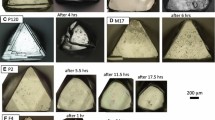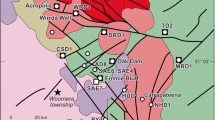Abstract
Mantle minerals undergo dissolution while being transported by kimberlite magma from the depth to the surface of the Earth. In this study, we experimentally investigate morphology of dissolution features developed on chromite crystals in the presence of H2O-rich and CO2-rich fluid and compare them to the features on natural kimberlite-borne chromite macrocrysts from Misery, Beartooth, and Grizzly kimberlites, Ekati Mine, Canada. The experiments were done in a piston-cylinder apparatus at 1,350–1,400 °C and 1 GPa in a synthetic CaO–MgO–SiO2 ± H2O–CO2 system with 0, 5, 13, and 15 wt % H2O, and 5 and 27 wt % CO2. The surface of chromite crystals with experimentally and naturally induced resorption was studied using a field-emission scanning electron microscope (FE-SEM). It showed angular or smooth steplike dissolution features developed in the presence of H2O-rich fluid and highly irregular surfaces with cavities, knobs, and polyhedrons developed in the presence of CO2 fluid. Naturally resorbed chromite grains from volcaniclastic Ekati kimberlites (Misery and Beartooth) show steplike features that are like the products of H2O-bearing experiments, whereas grains from hypabyssal (coherent) Grizzly kimberlite have irregular surfaces with flakes and spikes that do not resemble any of our experimental products. We propose a high H2O:CO2 ratio in kimberlitic fluid and a potential for using chromite morphology for investigating the volatile system within kimberlite magma and its effect on diamond preservation.
Access this chapter
Tax calculation will be finalised at checkout
Purchases are for personal use only
Similar content being viewed by others
References
Afanasiev VP, Zinchuk NN, Pokhilenko NP (2001) Morphology and morphogenesis of kimberlite indicator minerals. Publishing house of SO RAN, Russia, Novosibirsk, p 276
Bohlen SR (1984) Equilibria for precise pressure calibration and a frictionless furnace assembly for the piston-cylinder apparatus. Neues Jahrbuch fuer Mineralogie 9:404–412
Brearley M, Scarfe CM (1986) Dissolution rates of upper mantle minerals in an alkali basalt melt at high pressure: an experimental study and implications for ultramafic xenolith survival. J Petrol 27:1157–1182
Brooker RA, Sparks RSJ, Kavanagh JL, Field M (2011) The volatile content of hypabyssal kimberlite magmas: some constraints from experiments on natural rock compositions. Bull Volcanol 73(8):959–981
Canil D, Fedortchouk Y (1999) Garnet dissolution and the emplacement of kimberlites. Earth Planet Sci Lett 167:227–237
Eggler DH, Burnham CW (1984) Solution of H2O in diopside melts; a thermodynamic model. Contrib Miner Petrol 85(1):58–66
Fedortchouk Y, Canil D, Carlson JA (2005) Dissolution forms in Lac de Gras diamonds and their relationship to the temperature and redox state of kimberlite magma. Contrib Miner Petrol 150:54–69
Fedortchouk Y, Matveev S, Carlson JA (2010) H2O and CO2 in kimberlitic fluid as recorded by diamonds and olivines in several Ekati Diamond Mine kimberlites, Northwest territories, Canada. Earth Planet Sci Lett 289:549–559
Garvie OG, Robinson DN (1982) The formation of kelyphite and associated sub kelyphitic and sculptured surfaces on pyrope from kimberlite. In: Kornprobst J (ed) Third international kimberlite conference, vol 11A. Elsevier Sci. Publ., Amsterdam, pp 371–382
Gurney JJ, Hildebrand PR, Carlson JA, Fedortchouk Y, Dyck DR (2004) The morphological characteristics of diamonds from the Ekati property, Northwest territories, Canada. Lithos 77:21–38
Hilchie L (2011) Zonation of hydrogen in kimberlitic and mantle olivines: a possible proxy for the water content of kimberlite magmas. Department of Earth Sciences, MSc, p 85. Dalhousie, Halifax
Ikeda K, Yagi K (1982) Crystal-field spectra for blue and green diopsides synthesized in the join CaMgSi2O6-CaCrAlSiO6. Contrib Miner Petrol 81:113–118
Khokhryakov AF, Pal’Yanov YN (2010) Influence of the fluid composition on diamond dissolution forms in carbonate melts. Am Mineral 95(10):1508–1514
Kjarsgaard BA, Pearson DG, Tappe S, Nowell GM, Dowall DP (2009) Geochemistry of hypabyssal kimberlites from Lac de Gras, Canada: comparisons to a global database and applications to the parent magma problem. Lithos 112S:236–248
Leblanc M (1980) Chromite growth, dissolution and deformation from a morphological view point: SEM investigations. Mineral Deposita 15:201–210
Lee DC, Maddren J, Griffin BJ (2004) The importance of chromite morphology in diamond exploration. In: 8th international kimberlite conference long abstract, Victoria, p 5
Nikolenko EI, Afanasiev VP, Chepurov AI (2012) Fe-rich ilmenite and kimberlite melt interaction, experimental researches, long abstract: 10th international kimberlite conference, Bangalore
Robles-Cruz SE, Watangua M, Isidoro L, Melgarejo JC, Galí S, Olimpio A (2009) Contrasting compositions and textures of ilmenite in the Catoca kimberlite, Angola, and implications in exploration for diamond. Lithos 112 S:966–975
Skinner EMW, Marsh JS (2004) Distinct kimberlite pipe classes with contrasting eruption processes. Lithos 76(1–4):183–200
Watson EB, Wark DA, Price JD, Vanorman JA (2002) Mapping the thermal structure of solid-media pressure assemblies. Contrib Mineral Petrol 142:640–652
Acknowledgments
We thank Jon Carlson and BHPBilliton Diamonds Inc. for providing kimberlite concentrate for this study. Dan MacDonald is thanked for the help with EMP analyses, Patricia Scallion for the help with SEM work, and Institute for Research in Materials for the access to the FE-SEM funded by Canada Foundation for Innovation. We thank Chris Smith for very helpful review of the earlier version of this manuscript. This research was supported by NSERC of Canada Discovery and RTI grants to YF.
Author information
Authors and Affiliations
Corresponding author
Editor information
Editors and Affiliations
Electronic Supplementary Material
Below is the link to the electronic supplementary material.
Rights and permissions
Copyright information
© 2013 Geological Society of India
About this paper
Cite this paper
Fedortchouk, Y., McIsaac, E. (2013). Surface Dissolution Features on Kimberlitic Chromites as Indicators of Magmatic Fluid and Diamond Quality. In: Pearson, D., et al. Proceedings of 10th International Kimberlite Conference. Springer, New Delhi. https://doi.org/10.1007/978-81-322-1170-9_19
Download citation
DOI: https://doi.org/10.1007/978-81-322-1170-9_19
Published:
Publisher Name: Springer, New Delhi
Print ISBN: 978-81-322-1169-3
Online ISBN: 978-81-322-1170-9
eBook Packages: Earth and Environmental ScienceEarth and Environmental Science (R0)




